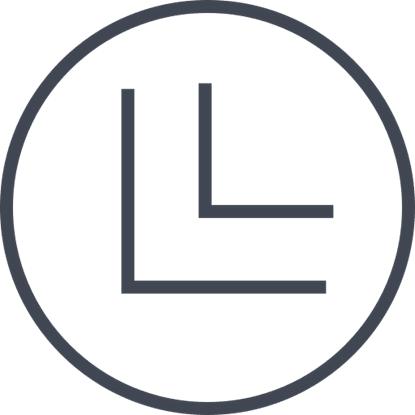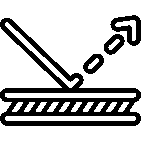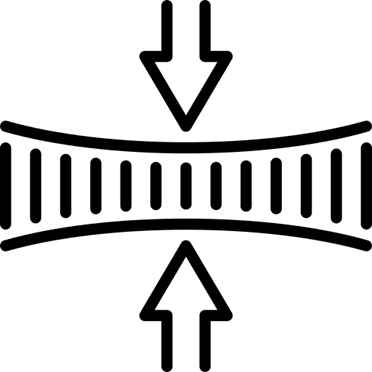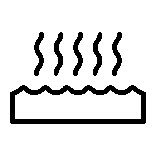Laser Cut Buna-N-Rubber Service
In the late 1920s and early 1930s, chemists Erich Konrad and Eduard Tschunkur succeeded in synthesizing a new rubber compound, which was patented in 1934, and they called it Buna-N-Rubber. The research was prompted by the shortage of rubber compounds that Germany faced during World War I. The “Bu” came from butadiene, “na” from sodium (which was used as a catalyst), and “N” from acrylonitrile (nitrile). Today it is also known as nitrile butadiene rubber (NBR). For manufacturing components from Buna-N-Rubber, one method used is laser cutting. Laser cutting machines use this technology as an effective means for processing Buna-N-Rubber, particularly for creating intricate and precise gaskets, O-rings, seals, and other profiles where the need to sustain crucial fluidics and gas systems. Laser cutting of rubber compounds is not new, but still there are many questions about laser technology so the following questions and answers are provided for further insight.
On The Edge
What Edge Quality Can Be Expected When Laser Cutting Buna-N-Rubber? Are Burrs or Heat-Affected Zones (HAZ) Present?
When laser cutting Buna-N-Rubber, you can expect a very good edge quality, but it’s important to manage the process parameters to avoid some common side effects.

- Clean and Sealed Edges: Lasers such as UV or ultraviolet technology vaporize the material, creating a clean cut with a smooth, melted, and sealed edge. This is a significant advantage over mechanical cutting methods, as it prevents fraying and produces a finished part.
- Minimal Burrs: Unlike a mechanical cut that might leave burrs, a laser cut is generally burr-free. However, the thermal process of laser cutting can result in carbon residue along the cut line. This residue can typically be cleaned off with an appropriate solvent or “dry wipe” with a lint free paper or cloth.
- Heat-Affected Zones (HAZ): The heat from the laser will create a small heat-affected zone on the material immediately adjacent to the cut. This can result in slight discoloration or a hardened edge, but with the right power and speed settings, the HAZ can be minimized to prevent a significant change in the material’s properties.
Characteristically Rubber
How Do Material Characteristics Like Reflectivity, Softness, or Thermal Conductivity Affect Edge Quality and Tolerance Control in Buna-N-Rubber?
Material Characteristic Effect on Edge Quality and Tolerance can affect dramatically the outcome of any intended component. To keep unwanted effects from occurring, laser cutting specialists must adjust parameters to meet specifications.
Reflectivity: Buna-N-Rubber has a low reflectivity to the infrared wavelength of a UV laser. This is ideal, as it means the material absorbs most of the laser’s energy rather than reflecting it. This high absorption leads to a more efficient and cleaner cut, reducing the chance of the beam scattering or creating a rough, inconsistent edge.
Softness (Durometer): The softness or hardness of the rubber, measured in durometer, directly affects how the material reacts to the laser’s heat. Softer grades of Buna-N can be more prone to thermal deformation or melting if the laser speed is too slow or the power is too high. This can lead to a less defined edge and a wider kerf (the width of the cut). Harder grades are more rigid and tend to maintain their shape better, allowing for tighter tolerances.
Thermal Conductivity: Buna-N-Rubber has low thermal conductivity, meaning it doesn’t dissipate heat well. On one hand, it concentrates the laser’s energy at the point of contact, which makes for an efficient cut. On the other hand, low thermal conductivity means heat can build up rapidly around the cut area, leading to a larger heat-affected zone (HAZ). Controlling laser power, speed and cycles is crucial to minimizing the HAZ and maintain a high-quality edge.



Laser Cutting Vs…
How Does Laser Cutting Compare to Die-cutting, Waterjet, or CNC Machining of Buna-N-Rubber?
Manufacturing components made from Buna-N-Rubber are done from numerous methods with each having positive attributes and challenges. There is no complete best technology for the creation of Buna-N-Rubber parts, rather there is a method that is perhaps better for a specific project. The following table is a general observation:

Factors of Tolerance Control
What Are the Tightest Tolerances Your Laser Cutting Process Can Maintain When Cutting Buna-N-Rubber?
When utilizing UV lasers for cutting Buna-N-Rubber, the tightest tolerances that can be maintained are exceptionally precise, often down to +/- 1mil even finer. This high level of accuracy is a direct result of the UV laser’s “cold processing” method. This process is highly controlled and results in minimal heat-affected zones (HAZ), which are the primary cause of material warping, melting, and charring in other laser cutting methods. Because UV laser cutting avoids thermal stress that can distort the material, it is the ideal choice for creating micro-scale components with intricate details.
Key Benefits
What Are the Benefits of Laser Cutting Buna-N-Rubber?
Versatility comes to mind as benefit for using laser cutting machines with Buna-N-Rubber. Laser systems do not require extensive set up nor require costly tooling. The ability to support development stages of R&D and prototypes offer great options to industries and their perspective product development teams. With capabilities of tight tolerances and high edge quality, laser services providers are the preferred method for countless applications in aerospace, medical devices, oil and gas, electronics and many more. Please reach out to A-Laser and we will ne happy to review your project and determine if laser technology is the solution.
Final Thoughts
Today, Buna-N-Rubber is a versatile material used in numerous applications, including automotive hoses, gaskets, and O-rings, as well as in industrial rollers and medical gloves. Its durability and chemical resistance make it a staple in industries where contact with petroleum-based fluids is common. When it comes to manufacturing, laser cutting is a highly effective method for processing Buna-N-Rubber. It offers excellent precision and creates clean, sealed edges without the need for physical tooling. Compared to other methods, but it is not the final solution. Methods such as waterjet cutting, CNC machining, and die-cutting bring their own set of positive capabilities. As with all opportunities, the decision to go with one method over another should be based on the project’s factors to fulfill the designs requirements.
